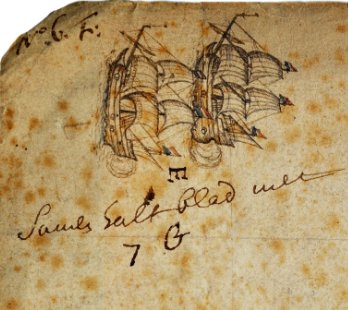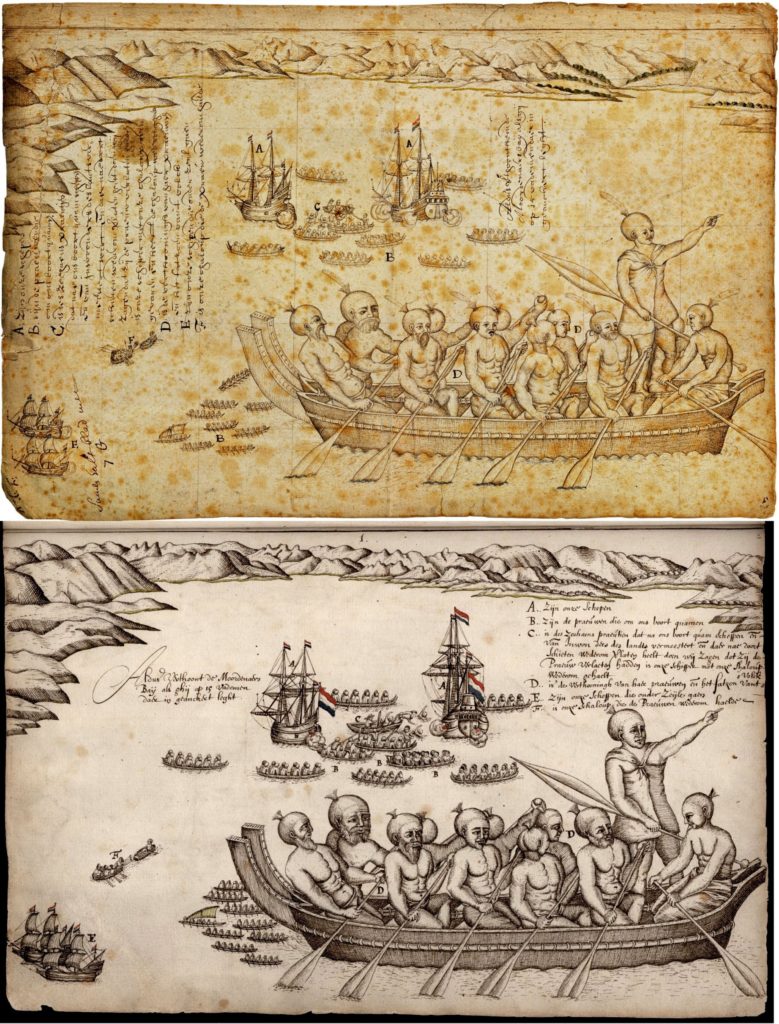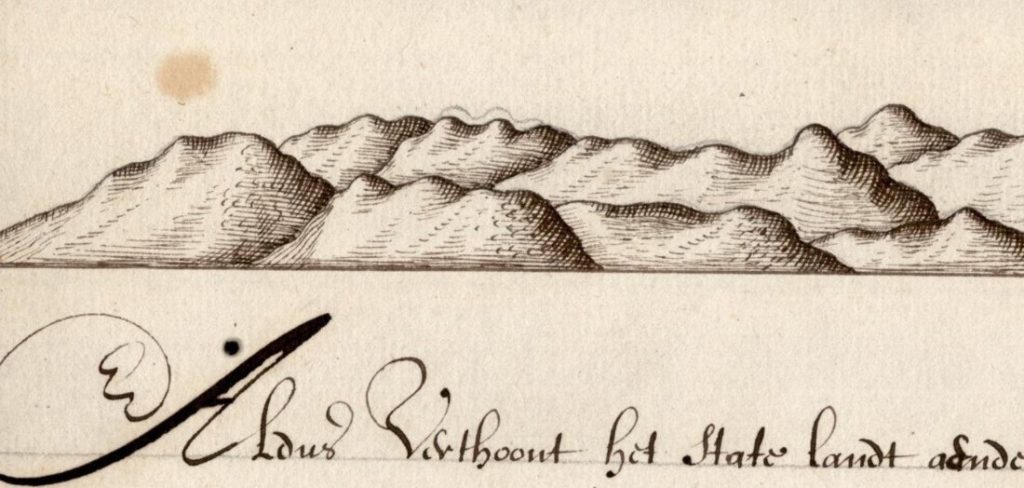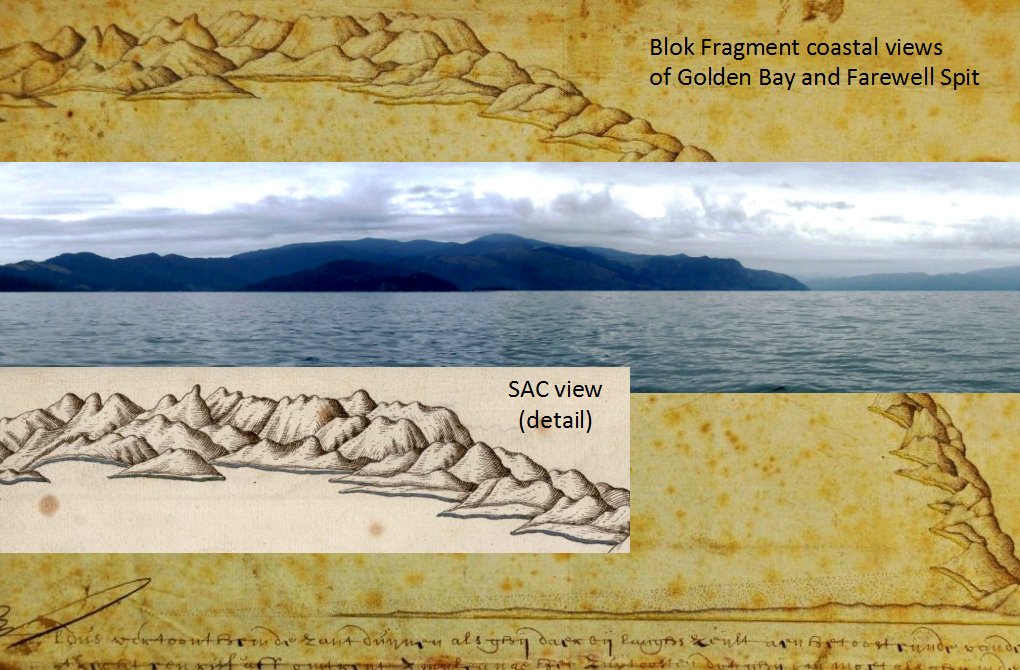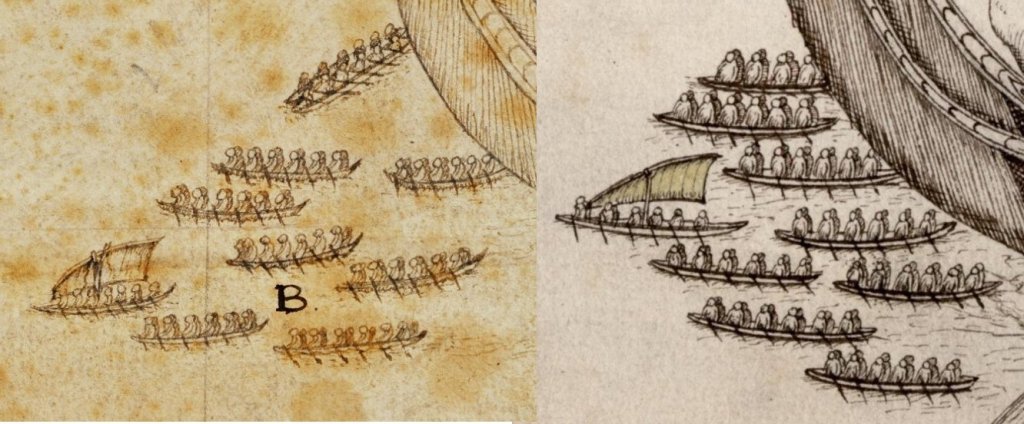Robert Jenkin writes:
What we now now know as the Blok fragment is a single leaf of paper slightly less than A3 in size with ink and wash drawings on both sides. It is held in the Netherlands State Archives and online photos of it there can be seen here
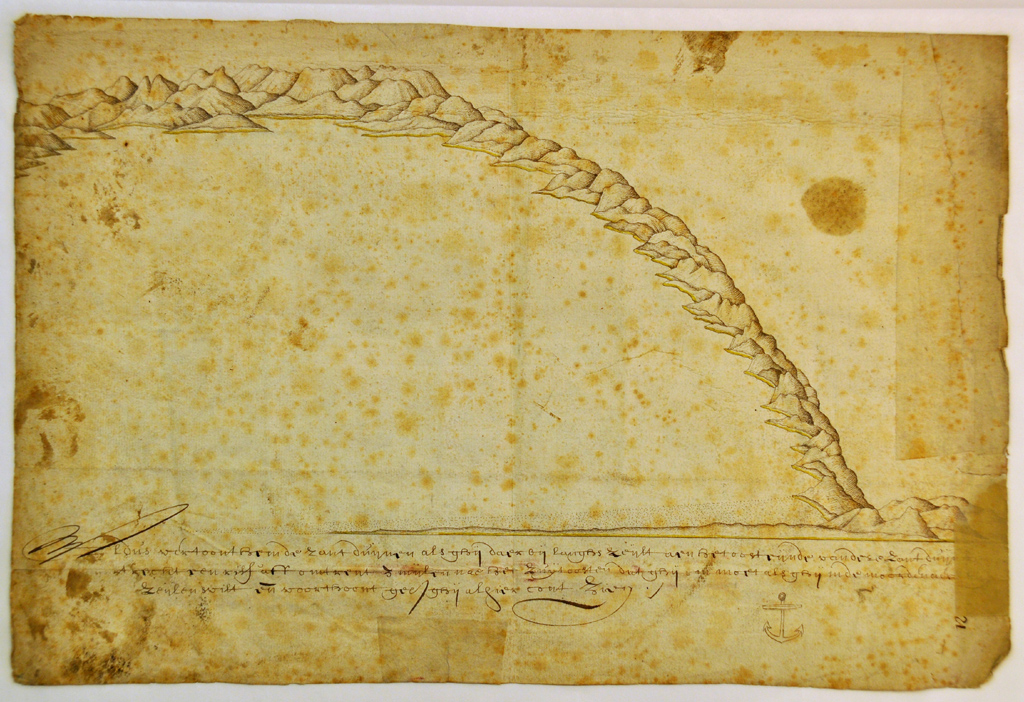
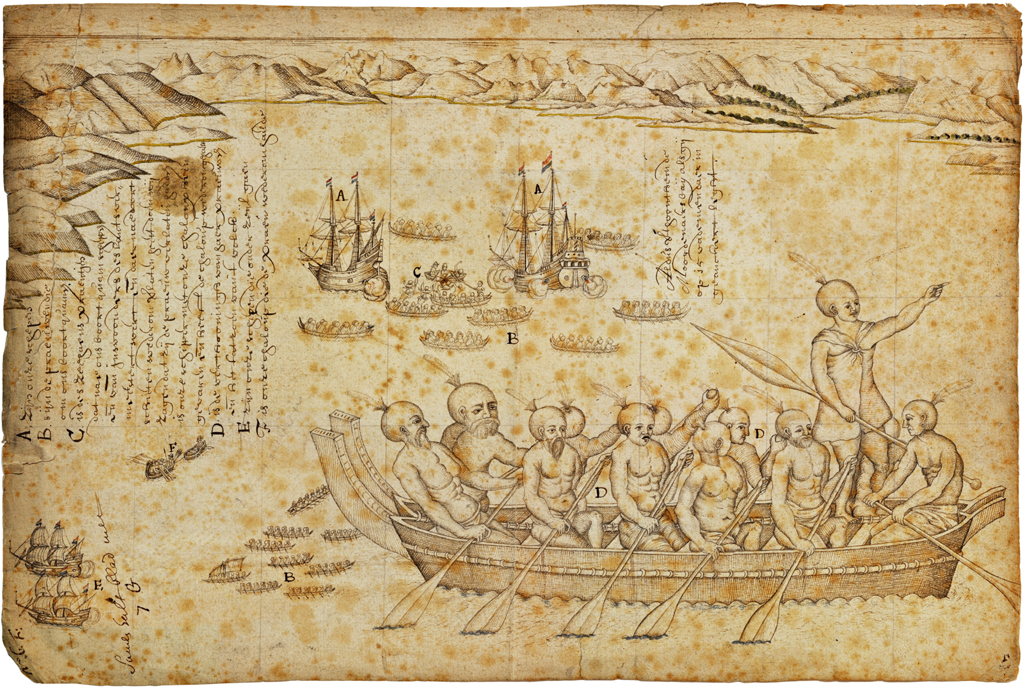 In Abel Tasman in New Zealand Waters; The Pictorial Record, an article R.D.J. Collins published in the Bulletin of New Zealand Art History in 1991, Collins convincingly suggests that the Blok versions of the illustrations shown above are the originals from which those in the SAC were later copied – I agree and discuss Collins’ observations further in a later post.
In Abel Tasman in New Zealand Waters; The Pictorial Record, an article R.D.J. Collins published in the Bulletin of New Zealand Art History in 1991, Collins convincingly suggests that the Blok versions of the illustrations shown above are the originals from which those in the SAC were later copied – I agree and discuss Collins’ observations further in a later post.
If we accept the Blok versions as the originals, what were their origin and purpose?
Blok seems to have had more exposure to the elements than SAC. Side one of Blok is numbered 21, suggesting it was once one of a set of numbered leaves. So was it part of such another illustrated text as SAC, all of whose other pages are now lost, as Heeres supposed, or could it be the last remaining leaf of all the illustrations drawn on Heemskerck by her designated artist (tekenaar)? Storage in a small warship during such an expedition could explain Blok’s weatherworn condition. For me this seems the likeliest theory based on the existing evidence, at least until more academic scholarship and perhaps some scientific testing can be brought to bear on Blok. Some of my reasons for believing that the drawings in it and in SAC are not the work of Gilsemans appear in my preceding post Van Diemen and his Councillors did not put all their artists in one barque and some on this page, Gilsemans’ earlier art.
What else is known of Blok? It rather than its SAC equivelant seems to have been the source of an illustration in François Valentijn’s 1726 book Oud en Nieuw Oost-Indiën (“Old and New East-India”). Valentijn served as a minister in the East Indies in the 1680s (Wikipedia) and he may then or later have had access to VOC’s secret archives, including the set of draft illustrations used in creating SAC and other Tasman Journal duplicates.
As Heeres explains: “The drawing of the fragment bears the following note written in an antique hand: “No. 6F. Samen half blad met 7G.” [No 6F, together with 7G to form a half-leaf]. This agrees with Valentijn, where 6F and 7G occur on one page, and the words “Samen half blad met” are in Valentijn’s own handwriting. Most certainly, therefore, the fragment is something of a relic: a fragment of a document used by Valentijn in the composition of his celebrated book.” (life, p.61)
Heeres’ explanation of these markings is clearly correct but does not mean Blok is a later work than SAC. All that it shows is Valentijn could access Blok and other illustrations like it at some time before his book came out in 1726 . He has, Heeres says, labelled side two of Blok ‘No 6F’. Apparently he labelled other leaves like Blok as well since the four words below the two departing ships above instruct his publisher that 7G should, with 6F take up one page or half-leaf, and indeed one published page in Oud en Nieuw Oost-Indiën presents an engraved version of ‘Abel Tasman’s Bay’ as No 7G with ‘Murderers Bay’ above it as No 6F.
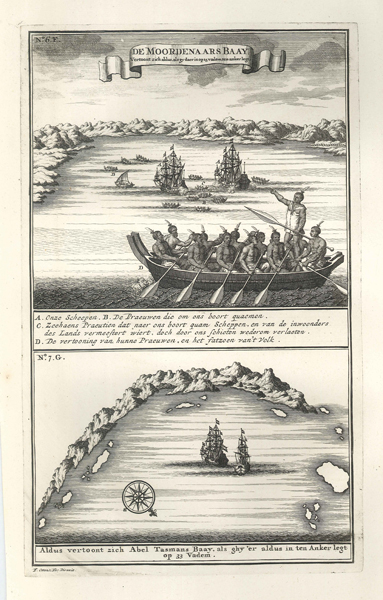 In Heeres’ analysis Valentijn’s text concerning Tasman is not from SAC but from another copy of the journal text (Life, p.84) and its engravings come from the collection that included Blok. If so one wonders whether other Oud en Nieuw Oost-Indiën engravings of the 1642-43 expedition may contain further documentary details that like the Maori feathers don’t appear in SAC.
In Heeres’ analysis Valentijn’s text concerning Tasman is not from SAC but from another copy of the journal text (Life, p.84) and its engravings come from the collection that included Blok. If so one wonders whether other Oud en Nieuw Oost-Indiën engravings of the 1642-43 expedition may contain further documentary details that like the Maori feathers don’t appear in SAC.
The number ’21’ on side one of the Blok probably dates from when it was first filed among other illustrated leaves, presumably in 1642 or 1643. The ‘2’ and ‘1’ don’t match the handwriting either of Gilsemans or of the man who captioned Blok and later wrote the main text of the SAC, but 21 does seem to be the number of the leaf.
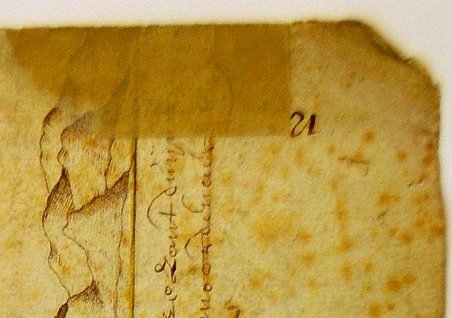 Heere’s had no doubt of SAC’s centrality. He called it ‘our copy’ and was convinced that all its illustrations were the work of Gilsemans, an idea he bequeathed to almost every subsequent authority. Like Collins Heeres observed that Maori headfeathers were not in SAC and were in Blok, like Collins he knew they were also in the text. But Heeres saw this as evidence that Blok was copied from the SAC . The feathers had to be a subsequent addition since, as he put it: “the draughtsman of the fragment, as in duty bound, has reinstated them on the heads of the natives, and from this picture they have no doubt found their way to Valentijn’s book.” I see this argument as somewhat back to front. Rather than being ‘reinstated’ in the Blok the feathers were where they belonged in Blok as the original but were left out in SAC since its new landscape captions left no room for them.
Heere’s had no doubt of SAC’s centrality. He called it ‘our copy’ and was convinced that all its illustrations were the work of Gilsemans, an idea he bequeathed to almost every subsequent authority. Like Collins Heeres observed that Maori headfeathers were not in SAC and were in Blok, like Collins he knew they were also in the text. But Heeres saw this as evidence that Blok was copied from the SAC . The feathers had to be a subsequent addition since, as he put it: “the draughtsman of the fragment, as in duty bound, has reinstated them on the heads of the natives, and from this picture they have no doubt found their way to Valentijn’s book.” I see this argument as somewhat back to front. Rather than being ‘reinstated’ in the Blok the feathers were where they belonged in Blok as the original but were left out in SAC since its new landscape captions left no room for them.
Some of the words in captions here and in the SAC suggest an author berthed on Heemskerck; e.g. “C.” in ‘Murderers Bay’ “is the Zeehaen’s praeutien that came paddling towards us and … was brought back by our skipper with our shaloup” and ‘F.’ refers again to ‘our shaloup’. While these might be considered words Tasman could use, it is a little difficult to see ‘our skipper’ and ‘our shaloup’ as words penned by Gilsemans, whose skipper wasn’t Holman and whose small boat was the Zeehaen’s praeutien, not Heemskerk’s shaloup.
Sharp shares Heeres’ view that captions in the Blok were written by the copyist of SAC’s main text. If one man worked on both then their creation dates and origins are close. Blok’s double-sided leaf is numbered 21; the corresponding illustrations in the SAC appear on pages 64 and 65. They aren’t back to back there as in Blok, instead appearing on side 2 of SAC leaf 31 and (facing page) side 1 of SAC leaf 32. So how account for that discrepancy of nearly twenty pages, ten whole missing leaves? Clearly the Blok is not a fragment of as full a journal as the SAC.
Heeres and Sharp both see Blok as part of a shorter version of the SAC, Sharp writes: “It would appear that the transcriber of the State Archives text … prepared a shorter copy of the journal and illustrations from which only the Blok fragment survives” (p.56) and in a footnote he admits that such conclusions “follow those of Heeres. Both authors are mistaken if we see Blok’s ‘Thus Appear the sand Dunes’ and ‘Thus appears the Murderers Bay’ as sources for, not copies of the SAC equivelants.
Blok has been labelled number 21, perhaps the 21st of all the illustrated leaves drawn by the expedition’s artist specialist. The first drawings in SAC are the Mauritius coast. Schouten instructed Tasman and his officers to order ‘proper drawings’ to be made of every unfamiliar coast and also charged them to investigate “the appearance and shape of the inhabitants, their dress, arms, manners, diet, means of livelihood, religion, mode of government, their wars and the like notable things, more especially whether they are kindly or cruelly disposed”. All this they were required to note, correctly to describe and to have “faithfully set forth in drawings.”
For coastal profiles pencil sketches would presumably be done, in every sort of weather from the open deck. Recording the events in Murderers Bay must have entailed frantic documentary drawing during or soon after them, cramming on paper every unfamiliar detail before, during and after the attack. Such rapid sketches may then have been polished and compiled into larger compositions below deck, probably while at anchor or while seas were calm enough and therefore often some time after the events that they depict. The anchorage in ‘Abel Tasman’s Bay’ from Dec 21-26 could well have been the time when Blok’s two compositions were created by the Heemskerck’s artist specialist.
Some of such illustration drafts may have been left out of the final illustrated day registers like SAC. There are just sixteen illustrated pages in the SAC before the two that make up both sides of the Blok. Those sixteen would take up only eight leaves, yet Blok is labelled 21. Twenty preceding leaves could have held forty finished illustration drafts preceding those of Blok, but twenty-four such drafts would hardly all have been left out? Supposing that they were, what of the thirty five more illustrated pages in the SAC, might fifty or so other drafts have been rejected in selecting them. Wastage on such a scale seems improbable.
It seems more likely that the set of illustrated leaves consisted of the artist’s pencil sketches and his inked-in final drafts, in which case, if the leaves were numbered as he filled them in, the number 21 on Blok could mean twenty-four pages of preceding pencil sketches and sixteen inked in drafts. This would accord with SAC and sounds quite plausible.
Some of the difference between the Blok and SAC Murderers Bays can be explained by quite a major redesign. The captions have been relocated and rotated into landscape view in SAC to match the images. This integrates the whole but evidently needed minor changes to some elements: the Heemskerck is presented more in stern view possibly to use less space; the head feather of the standing man, perhaps a time-keeper (kaiarahi), is left out in order to accommodate the captions just above; for the same reason he moves down into the left hull, displacing a twelth crew-member in Blok. Perhaps the other Maori feathers also went in order to preserve consistency. The whole attack scene also does move down in SAC, leaving less room for them.
Those who agree with Collins that the Blok is the original may wonder how much documentary evidence was lost or falsified if many other illustration drafts were also modified. But editorial changes weren’t always detrimental; the maro worn by the attacking Maori warriors, appear in SAC and not in Blok, perhaps supplied from other sketches or recalled from memory. Blok fragment’s ‘View of Murderers Bay’ and SAC’s equivalent has further details.
A pencil grid is visible in the Blok Murderers Bay, though not in that of SAC as can be seen by clicking on and then enlarging the above comparison. No matching grid appears on side one of the Blok. Possibly it was drawn on after SAC was made in 1643 by someone copying side two but not side one. Grids help with exact proportional copying, and neither Blok image is copied in that way in SAC. Later engravings are derived even more loosely from their Blok or SAC originals.
Lines that could possibly be pencil sketch lines can be seen on some pages of SAC as shown above. I’ve come to think the same artist drew both the Blok and SAC, altering SAC perhaps on editorial advice, and generally drawing there more boldly and decisively. The lines in Blok, however, seem more accurate. Supposing the headland seen at center left below in Blok and SAC coast outlines to be today’s Abel Tasman Point, the darker central headland in the modern photograph, the Blok draft view seems closer to modern reality. We would expect this if the Blok was the first copy from the documentary pencil sketch and SAC was later copied from the Blok.
Whatever may be lost we can’t really complain of what we have: the Blok with its two pages of original ink drafts has been preserved. At some time after Valentijn made use of it, its ‘Murderers Bay’ scene may have seemed too fascinating and important to be thrown away. Still having Blok is an extraordinary stroke of luck. It is a close to documentary drawing window on a time and place our best historians still guess about, halfway between the first arrival of our Maori settlers and our present day. A time perhaps when Maori waka like the voyaging canoe of which the Anaweka waka fragment was a part had not long ceased journeying to and from places as far as Rarotonga and beyond , a time perhaps when waka hunua like those depicted in the Blok and SAC sailed across or even into an opposing wind with tongiaki style sails such as these:

